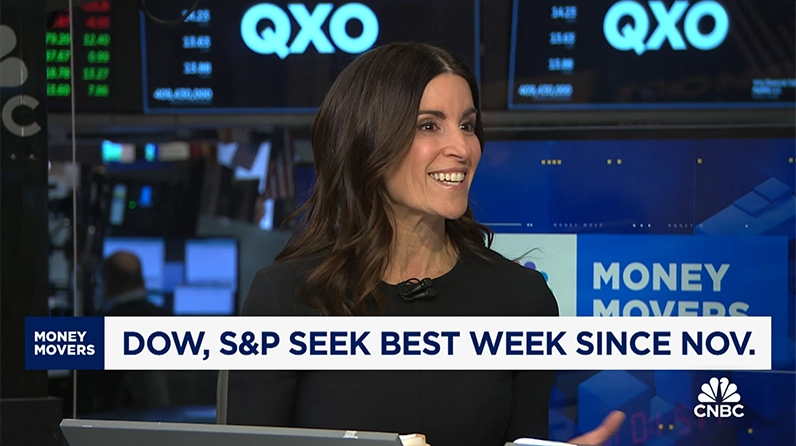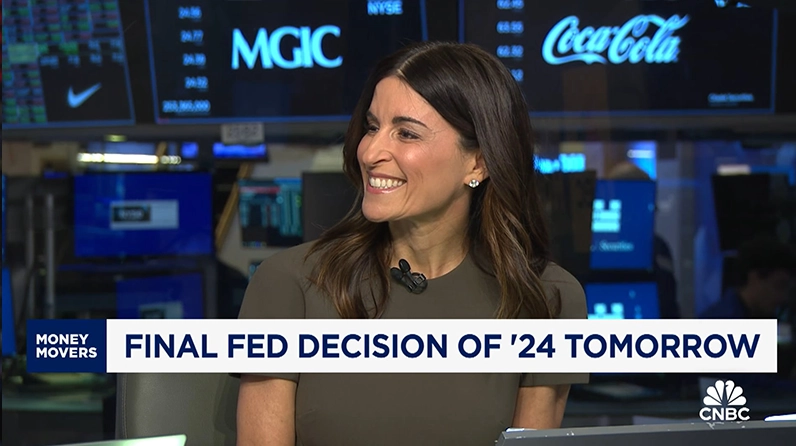

The Fed has made it clear that they are highly attuned to the need for balance in delivering on their dual mandate
Coming into this week, investors were seeking greater clarity on both fiscal and monetary policy, looking to the U.S. electorate and the Federal Reserve to provide that transparency. Former President Donald J. Trump’s victory in the U.S. presidential election (winning the popular vote and carrying the electoral college) was compounded in its impact by the Republicans exceeding expectations on gains in the Senate and most likely the House as well. The speed of the outcome was also surprising, with the lack of uncertainty – which had been widely expected – catalyzing significant rallies in pockets of the equity markets and further increases in U.S. Treasury rates.
Against this backdrop, and consistent with their continued move to a more accommodative stance, the Fed lowered the fed funds target rate by 0.25% to a range of 4.50% to 4.75%. The decision was unanimous, despite whispers of an upcoming pause becoming increasingly louder. The accompanying statement reflected the commitment to the Fed’s dual mandate of delivering maximum employment and inflation at the rate of 2% over the longer run, but also acknowledged that inflation remains somewhat elevated despite the progress made.
Of note from the subsequent press conference, Fed Chairman Jerome Powell pushed back on a prescriptive set of data as it relates to the December rate decision. While he acknowledged that economic data was stronger than what was reflected in September’s Statement of Economic Projections, he pointed to upcoming labor and inflation data as being instrumental in determining if a pause is appropriate. He also opined that the recent “run-up in bond rates” was attributable to a higher likelihood of stronger growth, and perhaps more limited downside risks, rather than a reflection of higher inflation expectations. Powell was unwilling to provide predictions on or a response to potential policy changes under the new administration but was quite succinct in his assertion that he will remain in his role as Fed Chair until his term expires in May 2026.
In our mind, the probability of a pause comes back to the downward trend in inflation; we maintain our expectation that we will see further deceleration down to 2.7% core CPI year-over-year in the first half of 2025. But we note that inflation remains well above the Fed’s target, and we believe a pause in rate cuts seems increasingly likely in the future although not necessarily this year. Consensus is converging to this view by pricing a terminal rate of around 4% but it will not be achieved without some volatility which we expect will persist and extend to long end rates as investors seek clarity on the Fed’s ultimate path.
While Powell was clear that he would not opine on potential policy changes, we are focused on the scope of Trump 2.0— what are possible scenarios for the Republican-led government regarding tariffs, immigration, regulation, and taxes and what are the implications for economic growth, inflation, and the level of interest rates. Tariffs are undoubtedly inflationary, and, while we have little specificity around the eventual size and scale of his tariffs, our preliminary estimate for increases in inflation due to tariffs as stated by Trump’s campaign is around 0.1% to 0.25% year-over-year. Similarly, it is too early to know the details of the President Elect’s immigration policy and how it will impact reductions in labor force supply and demand dynamics. As a result, our view is that an inflationary uptick may not manifest until the second half of 2025 – perhaps coinciding with the end of the Fed’s cutting cycle.
Helping to drive equities higher over the last two days is Trump’s intent to prioritize deregulation and industrial re-shoring, which has potential to spur “animal spirits” among US corporations (including small businesses) and drive increases in capital spending. Trump also has conveyed his intent to reduce energy prices to achieve disinflationary growth while boosting consumer confidence. From a fiscal perspective, Trump and Republicans have indicated that further tax cuts will be enacted, though we note tax rate reductions are more likely to eliminate a headwind by extending the TJCA cuts that expire at the end of 2025, rather than helping to create a new tailwind. Similar to our estimate on inflation above, and noting far more details are necessary, our preliminary projections are that pro-growth initiatives by the Trump Administration could be a modest boost to GDP in 2025, with potentially larger effects in subsequent years.
In short, the Fed has made it clear that they are highly attuned to the need for balance in delivering on the dual mandate. The fiscal landscape is changing, and in many ways the Fed is merely a consumer of those changes and in the same camp as consumers and corporations. While we believe the path of rates remains firmly downward, aligned with inflation, we acknowledge that the next twelve months could bring meaningful shifts within the global economy, and monetary policy, while likely not the star of the show, will no doubt play an important part in the success of the production.


INSIGHTS
CIO Notebook: Inflation Softer Following Strong Jobs Report

INSIGHTS
CIO Notebook: Firm Data Points Towards Fed Pause

MARKET COMMENTARY
New Year, New Winners?

INSIGHTS
CIO Notebook: Fed Cautious Ahead of Stronger Growth, Policy Changes

VIDEO
Holly Newman Kroft Discussed Year End on CNBC

MARKET COMMENTARY
Voters Unleash Animal Spirits

INSIGHTS
CIO Notebook: Inflation Higher in November as Fed Weighs December Cut
INSIGHTS
CIO Notebook: Fed Cut Likely as Unemployment Rate Rises
INSIGHTS
CIO Notebook: Inflation Comes in as No Surprise but Future Less Certain
VIDEO
Holly Newman Kroft Discussed Her Post Election Insights
MARKET COMMENTARY
Navigating the Uncertainty Before the Certainty
INSIGHTS
CIO Notebook: Shock Infested Data Shows October Payrolls Slowing
VIDEO
Sam Petrucci Featured on CNBC’s “Power Lunch”
IMPORTANT INFORMATION:
This material is provided for informational purposes only and nothing herein constitutes investment, legal, accounting or tax advice, or a recommendation to buy, sell or hold a security. This material is general in nature and is not directed to any category of investors and should not be regarded as individualized, a recommendation, investment advice or a suggestion to engage in or refrain from any investment-related course of action. Any views or opinions expressed may not reflect those of the firm as a whole. Neuberger Berman products and services may not be available in all jurisdictions or to all client types. Diversification does not guarantee profit or protect against loss in declining markets. Investing entails risks, including possible loss of principal. Investments in private equity are speculative and involve a higher degree of risk than more traditional investments. Investments in private equity are intended for sophisticated investors only. Unless otherwise indicated, returns shown reflect reinvestment of dividends and distributions. Indexes are unmanaged and are not available for direct investment. Investing entails risks, including possible loss of principal. Past performance is no guarantee of future results.
Portfolio positioning views expressed herein are those of Neuberger Berman’s Private Wealth Investment Group, which may include those of the Neuberger Berman’s Asset Allocation Committee. Asset allocation and positioning views are based on a hypothetical reference portfolio. The Private Wealth Investment Group analyzes market and economic indicators to develop asset allocation strategies. The Private Wealth Investment Group works in partnership with the Office of the CIO. The Private Wealth Investment Group also consults regularly with portfolio managers and investment officers across the firm. The Asset Allocation Committee is comprised of professionals across multiple disciplines, including equity and fixed income strategists and portfolio managers. The Asset Allocation Committee reviews and sets long-term asset allocation models, establishes preferred near-term tactical asset class allocations and, upon request, reviews asset allocations for large, diversified mandates. Asset Allocation Committee members are polled on asset classes and the positional views are representative of an Asset Allocation Committee consensus. The views of the Asset Allocation Committee and the Private Wealth Investment Group may not reflect the views of the firm as a whole and Neuberger Berman advisers and portfolio managers may take contrary positions to the views of the Asset Allocation Committee or the Private Wealth Investment Group. The Asset Allocation Committee and the Private Wealth Investment Group views do not constitute a prediction or projection of future events or future market behavior. Defensive positioning generally means an underweight bias on allocations to risk assets such as equities and alternatives. Positioning views may change over time without notice and actual client positioning may vary significantly. Discussion of yield characteristics or total returns of different asset classes are for illustrative purposes only. Such asset classes, such as equities and fixed income, may have significantly different overall risk-return characteristics which should be consider before investing.
The information in this material may contain projections, market outlooks or other forward-looking statements regarding future events, including economic, asset class and market outlooks or expectations, and is only current as of the date indicated. There is no assurance that such events, outlook and expectations will be achieved, and actual results may be significantly different than that shown here. The duration and characteristics of past market/economic cycles and market behavior, including any bull/bear markets, is no indication of the duration and characteristics of any current or future be market/economic cycles or behavior. Information on historical observations about asset or sub-asset classes is not intended to represent or predict future events. Historical trends do not imply, forecast or guarantee future results. Information is based on current views and market conditions, which will fluctuate and may be superseded by subsequent market events or for other reasons.
Discussions of any specific sectors and companies are for informational purposes only. This material is not intended as a formal research report and should not be relied upon as a basis for making an investment decision. The firm, its employees and advisory accounts may hold positions of any companies discussed. Nothing herein constitutes a recommendation to buy, sell or hold a security. It should not be assumed that any investments in securities, companies, sectors or markets identified and described were or will be profitable. Investment decisions and the appropriateness of this content should be made based on an investor's individual objectives and circumstances and in consultation with his or her advisors.
Neuberger Berman Investment Advisers LLC is a registered investment adviser.
The “Neuberger Berman” name and logo are registered service marks of Neuberger Berman Group LLC.